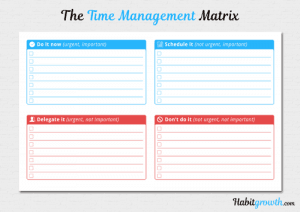🖊 This article was last updated on July 6, 2020
Has your to-do list ever been empty? If your answer is “Never,” you’re not alone.
Sometimes our to-do lists are even longer than our grocery lists. And each time we check off something on our list, several tasks get added.
Frustrating, isn’t it? As you grow your business or expand your career, that list will get even longer.
Even the productivity “gurus” and most seasoned entrepreneurs don’t get everything done. Yet they are, and continue to be, wildly successful. I’m sure you’re familiar with the success stories of the top entrepreneurs.
“What gives?,” you may ask.
It’s not that they have more time than we do. But they have been able to shift their mindset from making time to prioritizing things that matter most.
How to Prioritize Tasks on Your To-Do List

There are many ways to prioritize tasks, but these are the basic steps:
- Make a list
List everything you need to do
- Prioritize
What’s urgent? What’s important?
- Create a schedule
Plan your next actions
- Delegate
Delegate as much as you can to others
- Celebrate
Don’t forget to celebrate your accomplishments!
Let’s dive deeper into each step.
1. Make a list
The first step is to list everything you need to do. This list should include not only your daily tasks, but even your weekly, monthly, and yearly goals. Make sure that activities for your personal life–such as time with loved ones and friends, vacation/rest, and exercise–are included here.
2. Prioritize
Consider this: We have several short-term and long-term goals but we only have 24 hours each day. There’s only so much attention and energy we can give before the quality of our work begins to drop. Our personal resources are limited, so we have to focus on the tasks that will move the needle in our most important goals.
One of the most effective principles in prioritizing tasks (and one that has helped me a lot in my work) is separating what’s urgent from what’s important. Also known as the Eisenhower Principle (or Urgent-Important Matrix), it involves classifying tasks into four quadrants:

Quadrant 1: Important and urgent – These tasks need to be done now.
Quadrant 2: Important but not urgent – These often include our long-term goals like project deliverables, exercise, and strengthening our relationships. These activities must be scheduled in our calendar.
Quadrant 3: Not important but urgent – This may include phone calls and some meetings. Say “no” to some of these activities or delegate them so you can have more time for Quadrant 2 activities.
Start classifying your to-do’s following this matrix. (You can download a free template here.) I highly recommend that you allocate the bulk of your time and energy on Quadrant 2 activities, as these are guaranteed to have the biggest impact not just on your business but on key areas of your life.
But even after completing this matrix, we may still have an overwhelming list of Quadrant 1 and Quadrant 2 activities. We can use the Pareto Principle to further identify which activities should be done first. According to the Pareto Principle, 20% of our efforts yield 80% of the results.
Look at your list again and ask yourself: Which key tasks will generate the biggest impact/outcome? Do those tasks first.
These prioritization principles assume that you are aware of your values and goals. If you feel unsure or you haven’t really set any goals, consider making this list first. For instance, Nancy Daley suggests writing a to-be list, so we can focus on how we live our lives, not just on what we got done.
You can also set goals for different facets of your life. In an interview, artist-entrepreneurs Jon and Missy Butcher outlined the 12 categories covered in their Lifebook program. These categories include people’s personal lives, relationships, business (finance and career), quality of life, and life vision.
Find time to set goals for each category that matters to you, identify the activities that will help you move toward these, and schedule them in your calendar. Treat these activities as Quadrant 2 tasks, i.e., they are important and must not be at the mercy of urgent tasks.
3. Create a schedule.

Now that you have prioritized your tasks, put these in your calendar. While it’s tempting to squeeze in as many tasks as you could, you don’t really want your days to look like a scene from The Amazing Race, where you’re always in a rush. Allocate enough time for each activity, and schedule rests in between.
One technique that might help you is timeboxing. Set a fixed period of time (which can be several minutes to a few hours) for each activity. You can use this technique when checking your emails, so you don’t spend too much time on it but you also don’t miss important messages. For time-intensive project deliverables, divide these into smaller tasks and use timeboxing to work on each component gradually to avoid the deadline crunch.
4. Delegate
If you still don’t have enough time to do urgent or important tasks, consider delegating. Depending on your situation, you may consider delegating a less important task so you can free up time for your studies, career, or business. You can also delegate important tasks if these are outside your strengths. For example, if you need a website or a social media campaign for your consulting business, you can learn these skills yourself. But is it the best use of your time? You can hire professionals to do these things while you focus on the parts of your business that generate the most profit, such as client acquisition and retention.
5. Celebrate
As I mentioned above, your to-do list will never be empty. No matter how well you plan your day, there will be interruptions: a project may take longer than you planned, flights are delayed, or a family member may need your help.
Still, celebrate what you have accomplished. Notice your ta-da! list, i.e., the tasks you finished. Pat yourself on the back or maybe give yourself a treat at the end of the week.
Making your ta da! list is also your time to track your progress and reflect on areas that you can change or improve upon.
Next time you feel stressed out by your to-do list, remind yourself that your success and happiness do not depend on getting everything done. What truly matters is getting done the things that matter most to you.
What other strategies have you used to manage your to-do list? What challenges have you encountered as you prioritized your tasks? Share your thoughts below.
- These Black Friday deals will skyrocket your productivity (2021 edition) - November 11, 2021
- How to Stay Productive as a Digital Nomad - December 23, 2019
- When is the right time to outsource? - December 3, 2019


